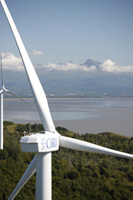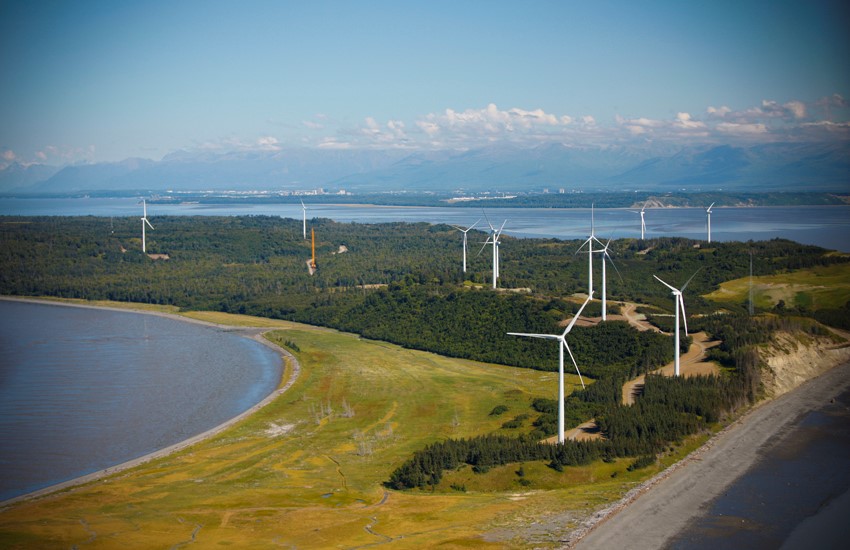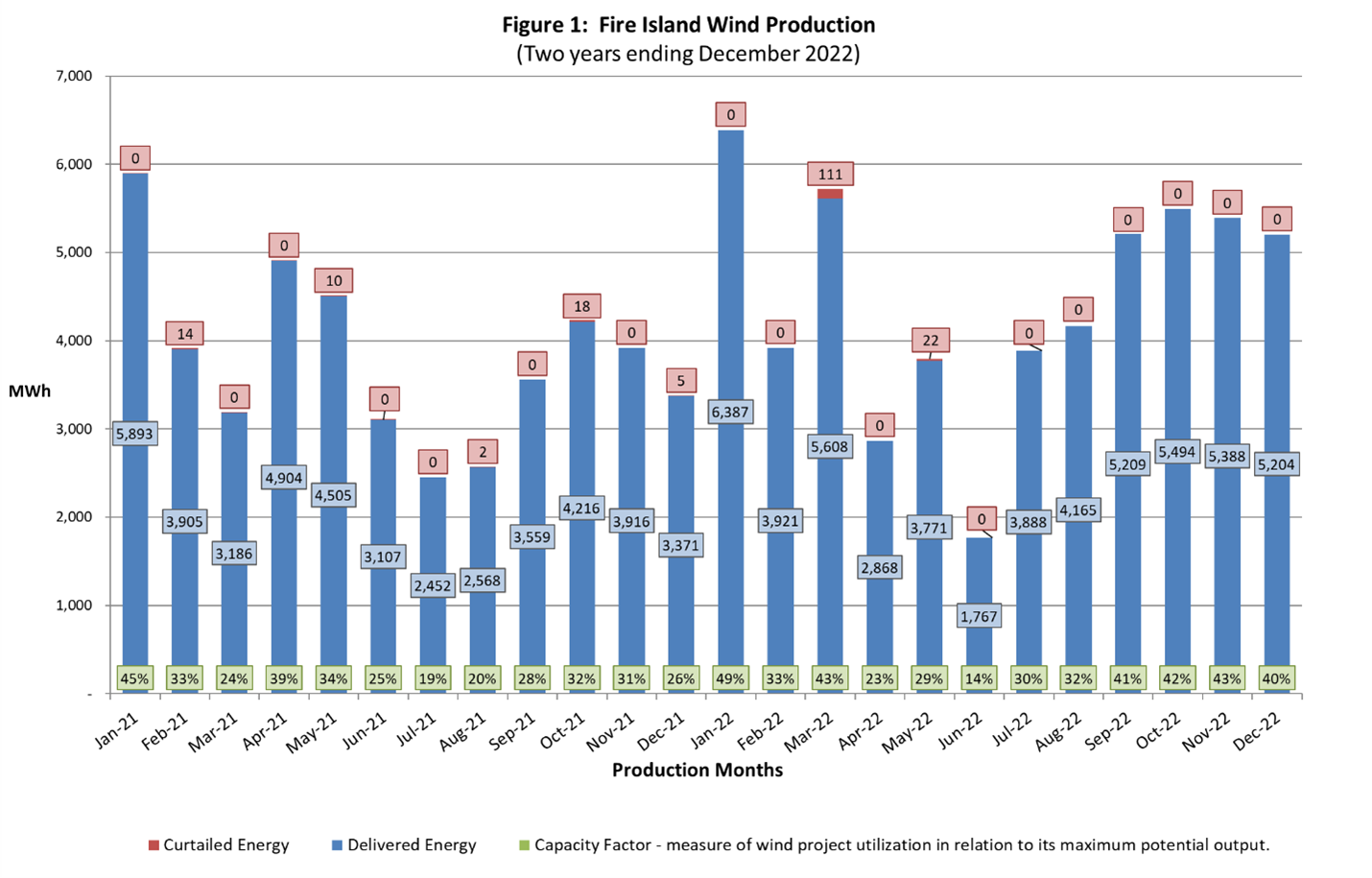Fire Island Wind

Chugach Electric purchases all the power generated by Fire Island Wind and delivers it to Chugach members. The project started production in September 2012 and supplies approximately 3% of Chugach’s retail load under a 25-year power purchase agreement with Cook Inlet Region Incorporated and its subsidiary Fire Island Wind LLC, who owns and operates the facility.

Background
For 15 years, Chugach pursued and assessed wind resources and potential development locations throughout its service territory, including Fire Island. Necessary studies were completed to evaluate the impact of Fire Island Wind on Chugach's system and consumers. These efforts resulted in an agreement with Fire Island Wind to purchase the output of its wind project located on Fire Island (Anchorage area map).
Fire Island Wind originally proposed a 52.8 MW wind farm to provide power to the entire Railbelt. The project was ultimately sized at 17.6 MW to provide energy solely to the Chugach service area. Fire Island Wind maintains an annual capacity factor of approximately 32 percent, provides an average output of approximately 5.8 megawatts, and produces approximately 47,500 MWh per year.
Fire Island is connected to Anchorage via a double circuit 34.5 kV sub-transmission line. The sub-transmission line is comprised of submarine, overhead and underground segments. The bulk of the transmission line was paid for with a $25 million grant from the State Legislature in 2008. This grant was specifically for the purpose of building a transmission line to Fire Island.
Wind power is different from Chugach's other sources of power in that it varies depending on the wind. The Fire Island Wind project provides Chugach with the experience of integrating a variable energy resource into our power supply portfolio. The knowledge Chugach is gaining by dispatching this resource increases our opportunities to provide stable, responsible and diversified energy in the future.
Wind energy varies by the hour, day, and season. Energy production is generally higher in winter when winds are more consistent and the air is colder, making it more dense. An example of the monthly wind variability is provided in the graphs below showing wind generation for two years ending December 2022, and a snapshot of one week’s wind energy shown in 15-minute intervals.


For more information on the project, construction and wind generators visit, Fire Island Wind LLC's website: www.fireislandwind.com.
Power Purchase Agreement
On October 10, 2011, the Regulatory Commission of Alaska approved a 25-year Power Purchase Agreement (PPA) between Fire Island Wind, LLC, a subsidiary of Cook Inlet Region Incorporated (CIRI), and Chugach Electric Association. Over the term of the PPA Chugach pays a fixed price of $97 per megawatt hour ($0.097 per kilowatt hour) for power made available by Fire Island wind generators.
Wind power acts, along with other largely fixed-priced resources like Bradley Lake and Cooper Lake hydro-electric power, as a counterbalance against significant fluctuations in the price of natural gas needed to supply the bulk of Chugach's electric energy.
Cost to Members
The cost of Fire Island Wind is higher than other sources of power in Chugach's generation portfolio. This is typical of new generation resources. For example, power from the Bradley Lake hydroelectric facility initially cost more per kWh than Chugach's other sources but now is among the lowest cost resources on the Railbelt. Fire Island Wind, like hydro electric power, has no fuel cost and delivers power at a consistent price for the duration of the 25-year power purchase agreement.
Fire Island Wind provides approximately 3% of Chugach’s combined North and South District retail kWh sales. Its total annual cost is on average approximately $4.8 million and it saves approximately $2.4 million of fuel and operational costs for a net cost of approximately $2.4 million per year. Unlike natural gas generators, the cost of Fire Island Wind is stable for 25 years, serving as a hedge on potential natural gas price increases. Chugach pays $0.097 per kWh for power made available by Fire Island Wind. This compares to the approximately $0.055 to $0.060 per kWh for power from other sources.
The impact of this wind energy on an individual retail member’s monthly bill for each customer class is identified in the line item “FIW Renewable Energy Adjustment” on a per kWh basis. For example, using the rates effective September 2023, the total bill for a typical residential customer using 525 kWh in the South District, the monthly bill is $122. Included is the cost of Fire Island Wind which is approximately $0.70, or about 0.5 percent.
Members may look to their monthly Chugach billing statement for the total cost impact of Fire Island Wind based on their actual monthly usage.
Renewable Energy Information
As a purchaser of Fire Island Wind power, Chugach earns a Renewable Energy Certificate (REC) for every megawatt hour of wind energy produced.
RECs represent the environmental and other non-power attributes of renewable electricity generation and are a component of all renewable electricity products, according to the Environmental Protection Agency.
The Fire Island Wind generation units are registered with North American Renewables (NAR) Registry and the associated RECs are created and tracked through NAR's accounting platform. The project has an approved tracking attestation on file with the Center for Resource Solutions (CRS). The RECs may be sold on the national voluntary market as well as retail markets to interested buyers. Chugach uses the revenue from sales of renewable energy certificates tied to the Fire Island Wind Project to offset the price of purchased power. Chugach sought the ratemaking treatment in a July 11, 2013 filing with the Regulatory Commission of Alaska.
If you would like more information about Fire Island Wind RECs, or are interested in purchasing RECs, please e-mail: sean_skaling@chugachelectric.com or call 907-762-4192.

Follow us for the latest service updates
Twitter Facebook YouTube